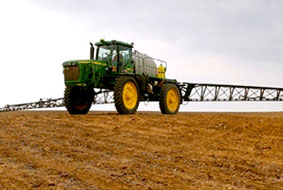High-tech farming
Today, American farmers are willing to invest in equipment, update new technology to support farming and know that the money they spend will bring more profit in the future.
Three years ago, Martin Barbre had known the automatic tractor system but had no need to use it nor did it think that it would help him cut down on farming costs. But more than a year later, when prices of fuel, seeds, fertilizer . began to rise, this 53-year-old corn and soybean farmer in Illinois started using the global positioning system (GPS ) for your tractor.'As soon as we use it, we have seen the benefits that this system brings,' says Barbre.
Since the late 1990s, owners of large farms have used tractor control equipment via GPS, sensors to check nutrients and moisture in the soil and other devices to cut production costs and increase productivity. However, it was not until 2003 that small and medium-sized farms realized that the application of high technology to production helped them offset the rising costs. Not only that, this measure also brings many environmental benefits such as limiting the use of fertilizers and herbicides, saving irrigation water, cutting fuel costs and, more importantly, helping to improve land. . In addition, farmers can also update new technologies via the Internet and include them in their production plans.

Farmers use GPS technology to spray herbicides.(Photo: Can Tho electronic newspaper)
The US Department of Agriculture said that compared to two years ago, fertilizer prices have nearly doubled while seeds and fuels have increased by approximately 50%. Meanwhile, the cost of equipped with automatic tractor system is almost no increase but also tends to decrease. These systems cost from a few thousand to a few tens of thousands of dollars, but in return, users can save labor and production costs. For example, with an automatic tractor device, the landlord only needs to define the land boundaries so that the GPS device can guide the tractor to divide the plot into aligned plots. As a result, they can save fuel as well as avoid seeding, fertilizing or spraying on the same lot. Barbre estimates that the automatic tractor system helps him save 5% on fuel costs for his 16,000 ha land area.
In addition, the output map - a system to monitor corn and soybeans used by Barbre over the past 10 years - also helped him increase the 30-35 USD profit per hectare of corn. Recently, he spent about 14,000 USD to buy and upgrade high-tech machinery and equipment for cultivation. As a result, the net profit he earned from 800 hectares is now up to 60,000-70,000 USD / year. However, according to Iowa State University professor of agriculture Matt Darr, the economic efficiency brought about by these technologies depends on the applicability of farmers. Surveys conducted by Purdue University and CropLife magazine in 2007 showed that 85% of farmers applied high technology to production but only 45% of them achieved profits.
In addition to technologies for GPS-based agricultural production, University of Illinois researchers are developing a small robot capable of identifying each seed in the field and spraying them with herbicides. As a result, farmers do not need to spray the type spread throughout the cultivated area as it has been for so long. The robot can move at 3.2 km / h and recognize seeds by color, location and other characteristics. It is expected that this product will be available in the market in a few years.
- Vietnam will have 10 high-tech agricultural zones in 2020
- High-tech farm of China: Production of 10 tons / day, only need 4 employees
- Stunned with high tech bus supercar in New York
- Techniques for growing jackfruit with superior yield
- Ostrich rearing gives high economic efficiency
- Explore the underground high-tech bicycle park in Japan
- Rescue dog wearing high-tech shirt
- What will the high-tech city look like in 30 years?
- High-tech farm model in the UK
- The reverse side of Hi-tech
- 'Exclusive' device at CeBIT
- Cashout Vietnam - a new version of Mafia
 'Barefoot engineer' invents a pipeless pump
'Barefoot engineer' invents a pipeless pump Process of handling dead pigs due to disease
Process of handling dead pigs due to disease Radiometer
Radiometer Warp Engine: Technology brings us closer to the speed of light
Warp Engine: Technology brings us closer to the speed of light